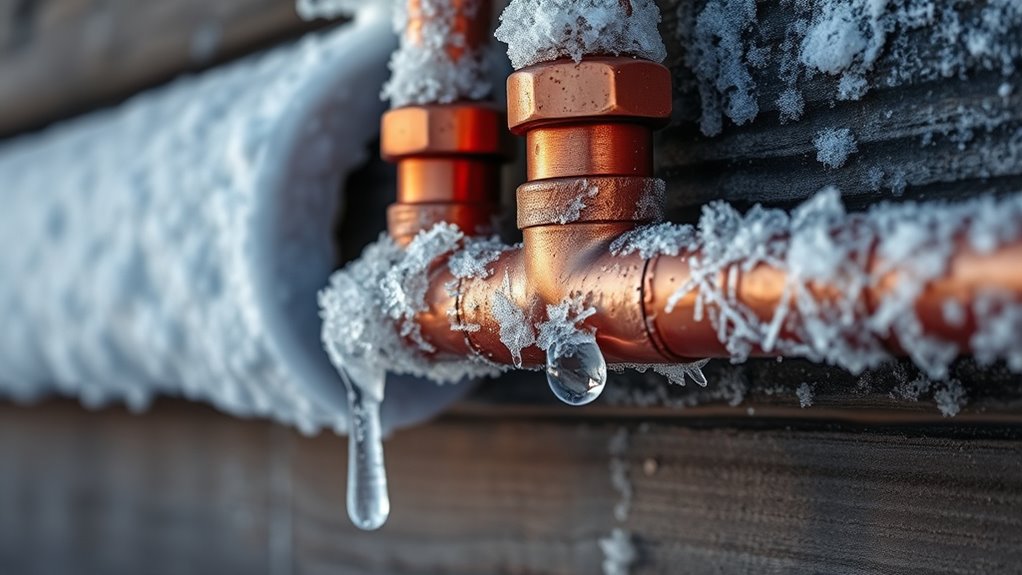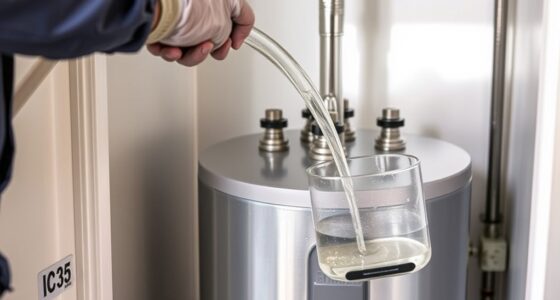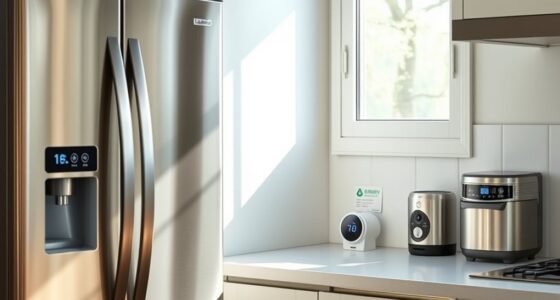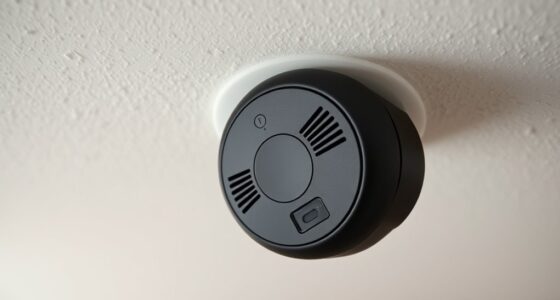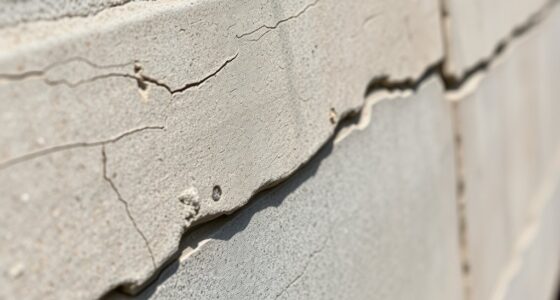To prevent a midnight burst, insulate exposed pipes with foam or heat tape, especially in unheated areas and along exterior walls. Keep your heat system running to maintain indoor temperatures above 55°F and let faucets drip slightly overnight to keep water moving. Seal gaps around windows and doors to block cold drafts. For added protection, open cabinet doors beneath sinks and ask neighbors to check on your home during extreme cold. Discover more tips to keep your pipes safe.
Key Takeaways
- Insulate exposed pipes with foam or heat tape, especially in unheated areas and near exterior walls.
- Let faucets drip slowly overnight to keep water moving and prevent freezing.
- Seal gaps around windows, doors, and vents to maintain indoor warmth and protect pipes.
- Keep indoor temperatures above 55°F and open cabinet doors under sinks for better heat circulation.
- Drain outdoor and vulnerable indoor pipes if you’ll be away during extreme cold to prevent freezing damage.
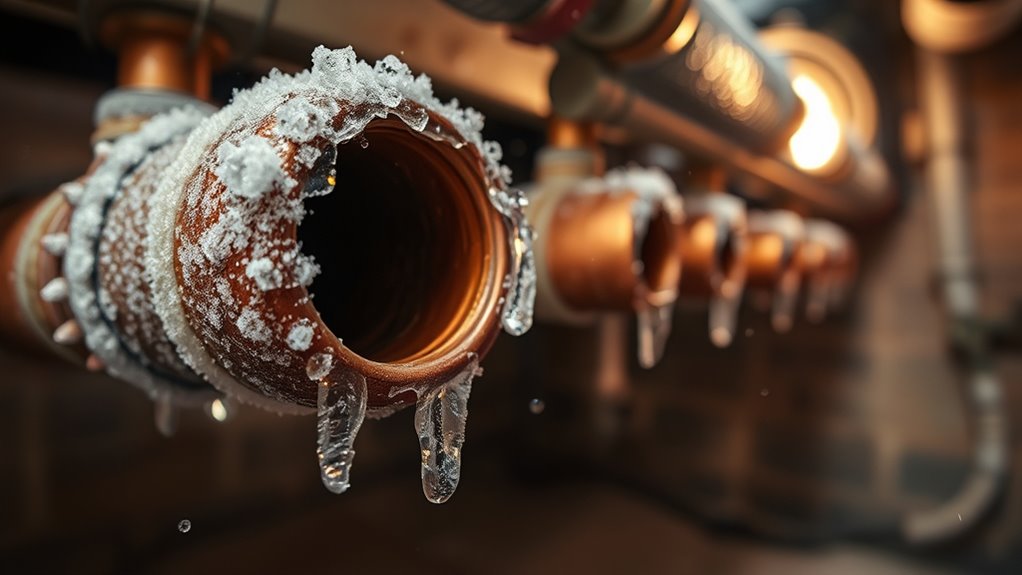
As winter approaches, it is essential to take steps to protect your pipes from freezing and bursting. When the temperature drops, water inside unprotected pipes can freeze, expand, and cause considerable damage. A burst pipe can flood your home, ruin belongings, and lead to costly repairs. Taking proactive measures now can save you from these headaches and expenses later.
Protect your home this winter by preventing frozen and burst pipes with simple, proactive steps.
Start by insulating exposed pipes, especially those located in unheated areas like basements, attics, garages, and crawl spaces. Use foam pipe insulation or heat tape to wrap these vulnerable sections. These materials create a barrier that keeps cold air out and helps maintain a stable temperature inside the pipes. Pay extra attention to pipes running along exterior walls or near windows, as they’re more exposed to the cold.
Another vital step is to let your faucets drip during particularly cold nights. When water is constantly moving, it’s less likely to freeze. Allow a slow, steady stream from faucets connected to exposed pipes. This simple act can prevent the water inside from stagnating and freezing, especially during prolonged cold spells. Remember to keep cabinet doors open under sinks, especially those on exterior walls, so warm air can circulate around the pipes.
Seal any gaps or cracks around windows, doors, and vents where cold air might seep in. Even small openings can cause enough cold air to reach your pipes, increasing the risk of freezing. Use weather stripping, caulk, or draft stoppers to close these gaps effectively. Also, ensure your home’s overall heating system is functioning well and maintaining a consistent, safe temperature—ideally above 55°F (13°C)—even in unoccupied spaces.
If you’re going away for an extended period, set your thermostat to a minimum of 55°F and ask a neighbor or friend to check on your house periodically. Alternatively, consider shutting off the main water supply and draining the pipes to eliminate the water that could freeze and cause damage. This step is especially important if you live in areas with extremely harsh winters.
Finally, keep an eye on the weather forecast and prepare in advance for cold snaps. By insulating pipes, maintaining steady indoor temperatures, and staying vigilant, you greatly reduce the risk of dealing with a burst pipe at midnight. These small steps can make a big difference in safeguarding your home and avoiding the chaos and expense of winter water damage.
Additionally, upgrading your home’s insulation or considering tuning your heating system can help maintain a more consistent indoor temperature, reducing the chance of pipes freezing.
Frequently Asked Questions
When Is the Best Time to Winterize My Pipes?
You should winterize your pipes before the temperatures drop consistently below freezing, ideally in late fall or early winter. Keep an eye on local weather forecasts and prepare when you see overnight lows approaching 20°F or lower. Taking action early helps prevent pipe bursts and costly repairs. Don’t wait until a cold snap hits—winterize proactively so your pipes stay safe and functional throughout the cold months.
Can I Winterize Pipes Without Professional Help?
Yes, you can winterize your pipes without professional help. Did you know that 85% of burst pipes happen because homeowners skip winterization? You just need to drain outdoor hoses, disconnect sprinklers, and insulate exposed pipes. Turn off the main water valve, then open faucets to drain remaining water. With some basic supplies and a little effort, you can protect your pipes effectively and avoid costly repairs.
What Tools Are Needed to Winterize Pipes?
You’ll need a few essential tools to winterize your pipes effectively. Gather a wrench to turn off the main water supply, pipe insulation or foam covers to protect exposed pipes, a garden hose for draining outdoor lines, and a hairdryer to thaw frozen pipes safely. Additionally, have a towel or bucket handy to catch any residual water. These tools help prevent pipe bursts and make certain your home stays protected during cold weather.
How Do I Prevent Pipes From Freezing in Unheated Areas?
Like a fortress defending its treasure, you must shield your pipes in unheated areas from the cold. Insulate them thoroughly with foam or fiberglass insulation, seal any cracks or gaps where cold air might sneak in, and let faucets drip slightly to prevent freezing. Consider installing heat tape or portable heaters for extra warmth. These precautions act as a warm embrace, keeping your pipes safe during the harshest winter nights.
What Signs Indicate My Pipes Are Already Frozen?
You’ll notice your pipes are frozen if they’re difficult to turn on or if the water flows slowly or not at all. You might also see a bulge or frost on the pipe’s surface. Strange noises like banging or clanking can signal ice blockage. If you turn on a faucet and only a trickle comes out, it’s a clear sign. Address these signs quickly to prevent further damage.
Conclusion
By winterizing your pipes, you protect your home, prevent costly repairs, and avoid the inconvenience of burst pipes. You take control, you stay prepared, and you keep your home safe. Don’t wait for the cold to surprise you—insulate, drain, and disconnect. Stay proactive, stay warm, and stay worry-free. When you winterize your pipes, you guarantee peace of mind, comfort, and safety all season long.
